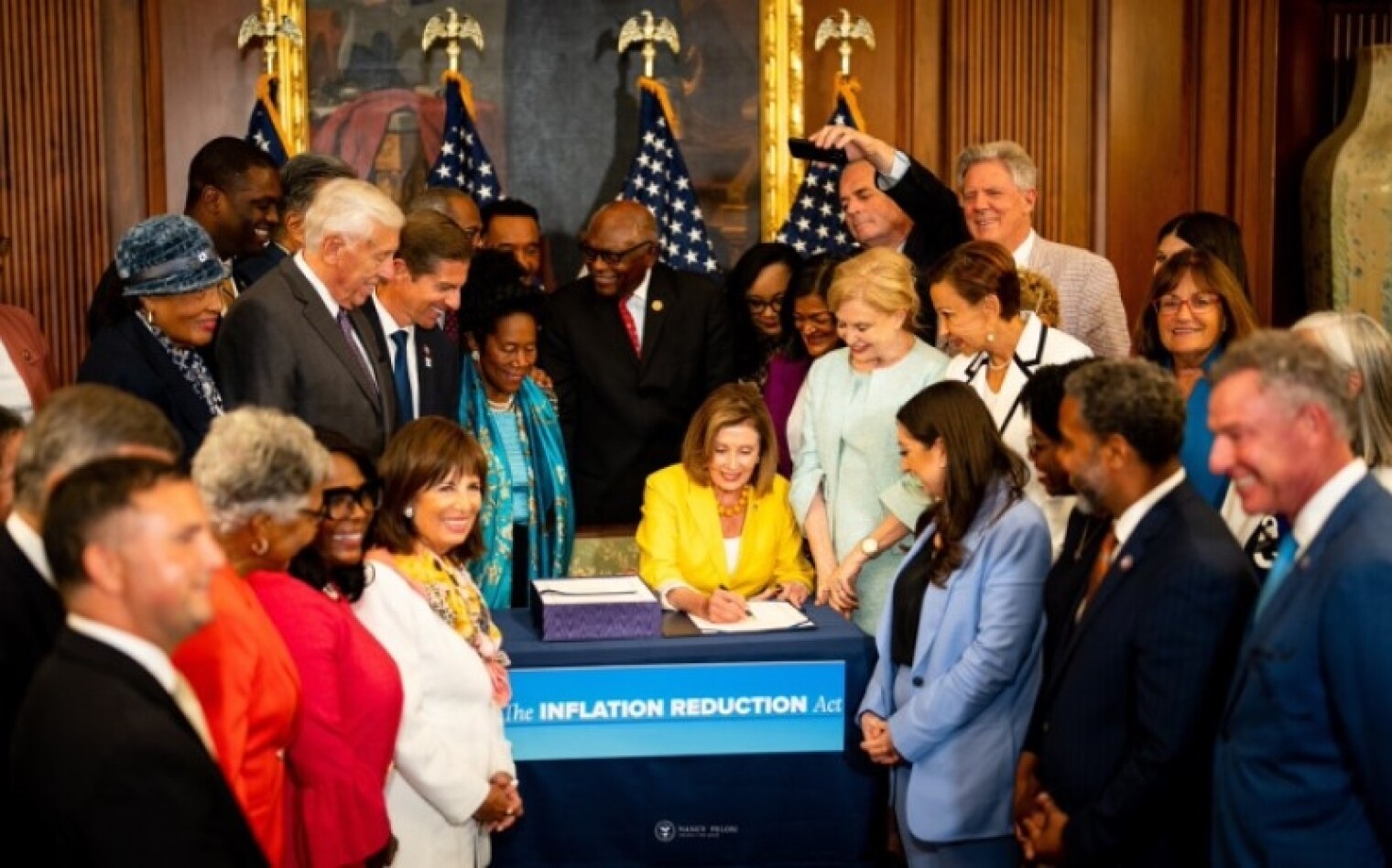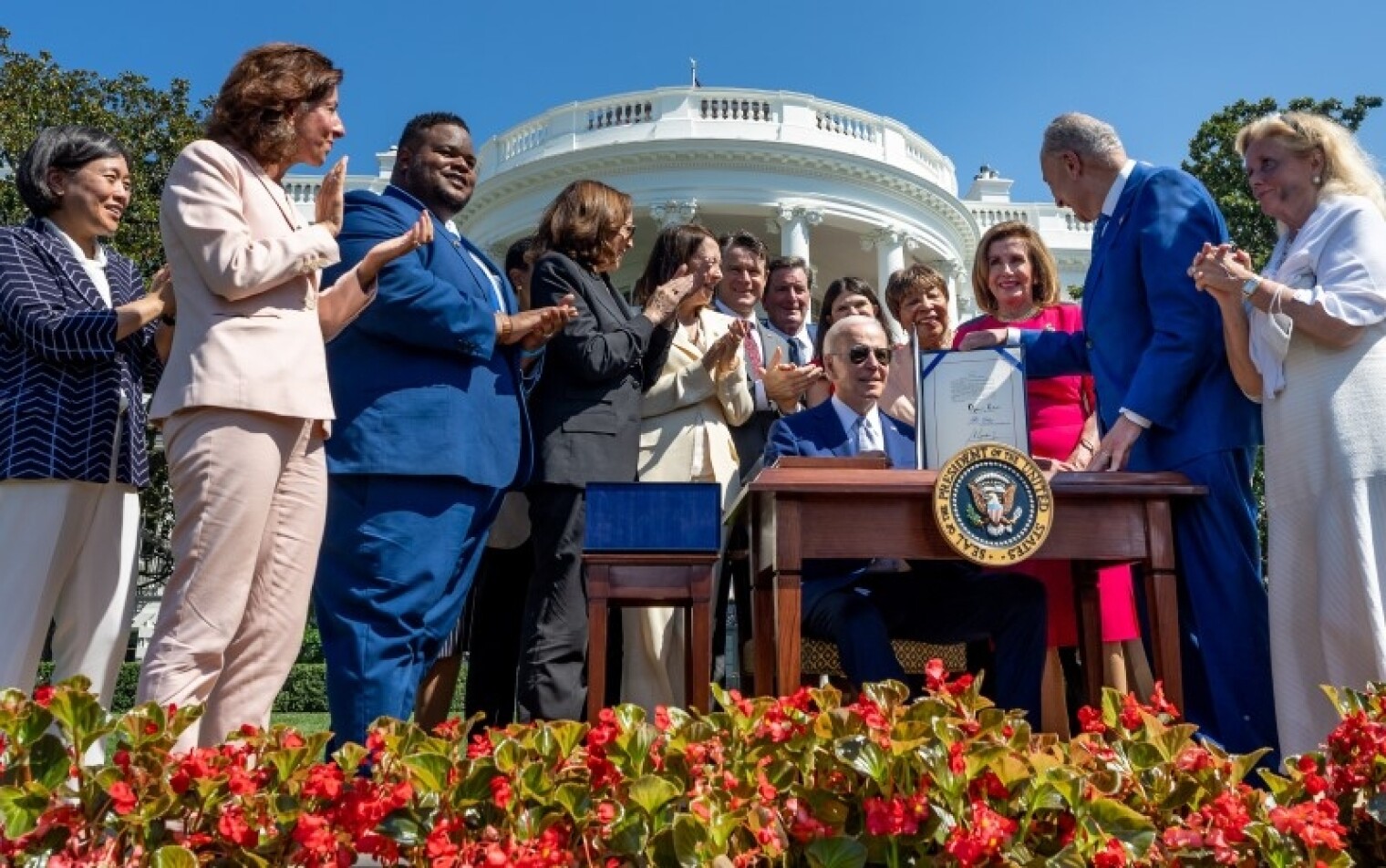| |
What’s Ahead
 |
| House Speaker Nancy Pelosi (D-CA) signs the Inflation Reduction Act on Aug. 12. (Image credit – Office of Speaker Pelosi) |
Landmark Climate Bill Reaches Finish Line
President Biden plans to sign the Inflation Reduction Act this week ahead of a bigger ceremony on Sept. 6. The law’s enactment concludes Democrats’ year-long effort to pass a sweeping spending and tax reform package and sets up the most expansive measures the U.S. has ever implemented to mitigate climate change. The Senate passed the bill on a vote of 51 to 50 on Aug. 7 and the House followed suit on Aug. 12 with a vote of 220 to 207, with Democrats unanimously supporting the bill in each chamber in the face of united Republican opposition. IRA’s climate-related provisions will cost about $370 billion and largely focus on decarbonizing the economy, boosting resilience against environmental hazards, and promoting environmental justice and energy affordability. Among these provisions, the bill will vastly expand the Department of Energy’s loan authority and provide billions of dollars for energy technology manufacturing initiatives and greenhouse gas emissions reduction projects at industrial facilities. It also includes nearly $500 million for research and forecasting activities at the National Oceanic and Atmospheric Administration. In addition, the bill will provide a one-time infusion of $2 billion for projects across DOE’s national labs that are not directly related to climate change.
|
|
In Case You Missed It
 |
| Signing ceremony for the CHIPS and Science Act. (Image credit – The White House) |
Biden Signs Chips and Science Act
President Biden signed the CHIPS and Science Act into law on Aug. 8 during an hour-long ceremony on the White House lawn. In his remarks, Biden said subsidy programs created by the law will help the U.S. compete with countries vying to attract semiconductor company investments, pointing specifically to China, Japan, South Korea, and the European Union. He further argued the science budget increases recommended in the law will “ensure the United States leads the world in the industries of the future — from quantum computing, to artificial intelligence, to advanced biotechnology.” Also delivering speeches were Senate Majority Leader Chuck Schumer (D-NY), House Speaker Nancy Pelosi (D-CA), and Commerce Secretary Gina Raimondo. A handful of Republican lawmakers attended the ceremony, including Sen. Todd Young (R-IN), who partnered with Schumer to draft and advance the legislation in the Senate, and Sen. Rob Portman (R-OH), whose state is hosting a major new semiconductor manufacturing complex built by Intel. In conjunction with the bill signing, the White House announced it plans to coordinate permits for “high-tech manufacturing” projects associated with the law through an interagency working group.
Among the law’s most immediate effects will be to create new programs at the Departments of Commerce and Defense to administer $52 billion in semiconductor R&D and manufacturing funds. However, many details remain to be worked out about the ultimate structure of these programs, including the location and form of a National Semiconductor Technology Center. The President’s Council of Advisors on Science and Technology sent a letter to Biden on Aug. 9 with initial recommendations on how to spend the R&D funds provided by the law, ahead of a full report it plans to release this fall. Beyond the “chips” provisions, which the law funds through mandatory appropriations, Congress will still have to fund much of the “science” portion through future appropriations. Science community representatives are now preparing campaigns to convince Congress to meet the law’s ambitious budget targets for science agencies, cognizant that appropriations for science agencies have fallen well short of authorized levels in the past. Some elements of the law will have enduring effects regardless of the ultimate appropriations, such as its many research security measures as well as provisions that prescribe the scope of the National Science Foundation’s new Directorate for Technology, Innovation, and Partnerships.
Democrats Press for Higher DOE Science Budget
Democrats on the House Science Committee sent a letter to the White House and the Department of Energy on Aug. 15 that asks them to develop a “robust budget proposal” for the DOE Office of Science for fiscal year 2024. The committee registered its disappointment in the administration’s fiscal year 2023 request for the office at a hearing earlier this year, and the letter notes that the newly signed CHIPS and Science Act sets out a significant ramp up in that budget that will have to be met through future appropriations. “It is imperative that we meet this historical moment with transformative investments in science and innovation, and that process begins with the president’s budget request,” the letter states. It further notes that proposed funding levels are insufficient to maintain schedules for many construction projects and do not fully account for impacts related to the pandemic and supply-chain disruptions, citing information received from project stakeholders and DOE itself.
|
|
Events This Week
All times are Eastern Daylight Time, unless otherwise noted. Listings do not imply endorsement.
Monday, August 15
Tuesday, August 16
Wednesday, August 17
Thursday, August 18
Friday, August 19
No events start today.
Monday, August 22
|
|
Opportunities NASA Hiring Goddard Director
NASA’s Goddard Space Flight Center is seeking a director to replace Dennis Andrucyk, who has led Goddard since Jan. 2020 and announced last month that he plans to retire. Headquartered in Greenbelt, Maryland, Goddard is one of two NASA centers that are principally focused on the development and operation of science missions. Applications are due Aug. 30.
APS Hiring Federal Relations Staff Member
The American Physical Society is hiring a federal relations associate whose portfolio will include policy issues related to the Department of Energy, Department of Defense, and national security, among other topics. Preferred qualifications include an advanced degree in physical sciences, public policy, or a related field, and at least three years of relevant work experience.
National Academies Hiring DEI Program Manager
The National Academies is hiring a program manager in its Office of Diversity and Inclusion. Among other duties, the program manager will manage quantitative and qualitative research projects and lead the development of a “DEI Toolkit” aimed at disseminating best practices for advancing equity and inclusion in STEMM. Applicants must have a bachelor’s degree in the social sciences or another STEMM field and at least three years of related professional experience.
Know of an upcoming science policy event either inside or outside the Beltway? Email us at fyi@aip.org.
|
|
Around the Web
News and views currently in circulation. Links do not imply endorsement.
CHIPS and Science Act
White House
Congress
Science, Society, and the Economy
Education and Workforce
Research Management
Labs and Facilities
Computing and Communications
Space
Weather, Climate, and Environment
Energy
Defense
Biomedical
International Affairs
|
|
|
| |
| |
|
